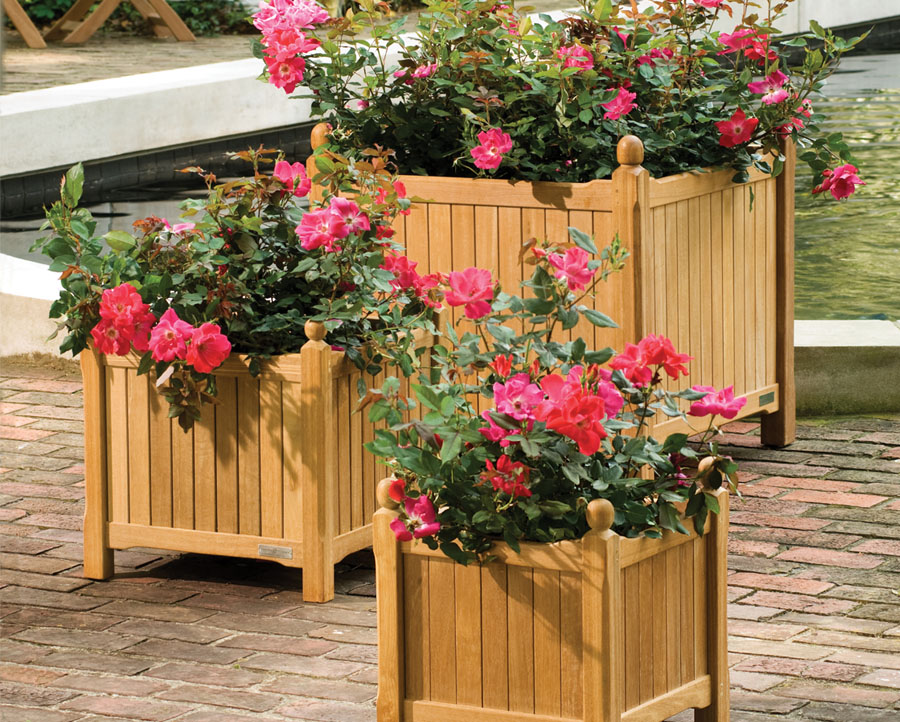Buyer's Guide for Commercial Planters
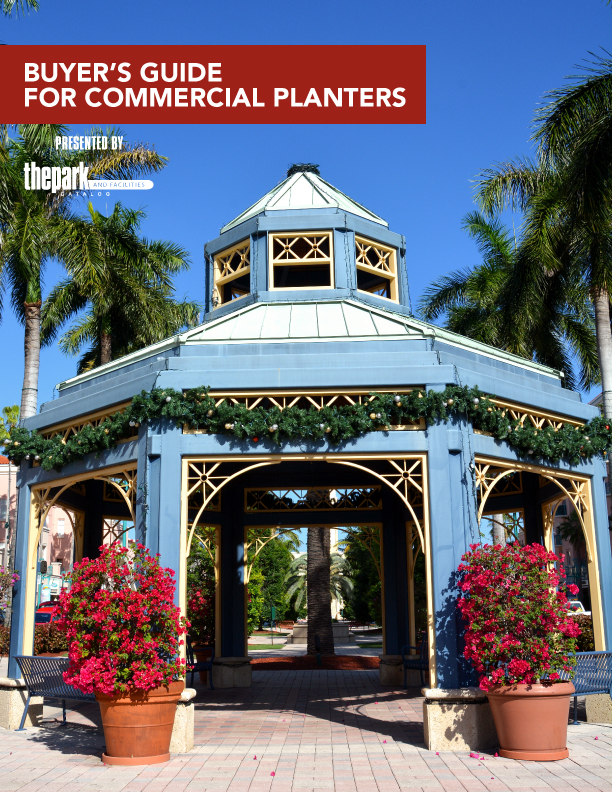
Why add commercial planters?
When making a list of necessary site furnishings, commercial planters might not be the first item on your list, but they probably should be. Commercial planters add an inviting tone to your facility, especially when they are filled with bright flowers and exotic plants. Their cost is minimal, but their impact in terms of curb appeal is huge. Researchers at Harvard University in conjunction with Massachusetts General Hospital found that participants in a study felt happier and more energetic after looking at flowers during the morning hours. The study also discovered that this boost of energy helped participants throughout the rest of their day.
Commercial wooden planters
Commercial planters can also act as buffers for auto and pedestrian traffic. Imagine the great effect these flowers could have on your guests or prospect customers. After feeling a positive vibe from your facility, they are likely to experience that feeling the rest of the day. Their friends and family may ask why they are so happy, or your guests might go out of their way to tell friends about their excellent experience at your business or park. Again, it might seem like the impact from commercial planters is minor, but it can leave a positive impression on your guests and bring more people to your facility, retail store, multifamily community or office building. Besides adding color, commercial planters can also help your facility function more smoothly. Looking to direct guests away from a closed area of your outdoor patio? Block the walkway with some large commercial outdoor planters or trees. A large, red DO NOT ENTER sign decreases the high-quality look and design of your space and can make guests feel uncomfortable. But a plant can communicate the same thing in a minimalist way. There are so many other reasons to add commercial planters, which we will explore further in this buyer’s guide. We will also explain how to select and install the perfect type of planter for your facility.
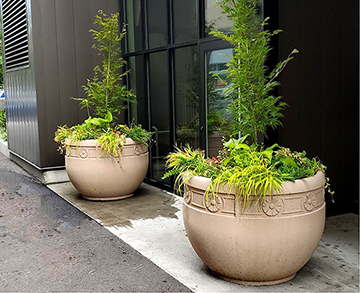
Commercial planters used as a buffer outside a hotel
Who should add commercial planters?
Are commercial planters right for your facility? Planters are excellent for almost every facility, but the way you implement them will vary from place to place.
- Retail centers and shopping malls. Facilities managers who run malls should carefully select and place commercial planters filled with seasonal, welcoming plants to make guests feel comfortable in a beautiful environment. One example of this is the NorthPark Mall in Dallas. Their excellent landscaping includes a unique 1.4-acre central garden, which serves as an urban getaway with sculptures, trees, lawn space, and of course beautiful plants.
Many malls are also favoring outdoor walkways to embrace more green space. If your facility doesn’t have room for this kind of green space, try to incorporate lovely plants throughout the mall, especially in areas where people congregate, such as near food courts, restrooms, and central seating areas.
- Office buildings can easily be drab if they aren’t carefully thought out. White walls and bland carpet are enough to bore tenants or employees very quickly. Interior decorations can boost the mood, but you will be shocked what something green and living can do for the vibe of your office. For open work environments, plants can help break up some of the space, reducing noise levels to boosting productivity.When adding commercial planters to your office, remember the entrance and reception areas, which leave a lasting impression (either positive or negative) on your guests or prospects tenants. Ambius, a landscape design company, has transformed open corporate atriums into lush green areas that revitalize employees while impressing recruits or visitors.
You can apply the same ideas to offices for lawyers, municipal leaders, or businesses large or small. Plants leave a positive impression, reenergize employees, and improve the internal air quality of all types of offices.
- Multifamily communities and apartment complexes. More newly constructed neighborhoods are shying away from expansive acreage for individual homeowners. Instead, many people live in neighborhoods with community parks, walkways, and shared green spaces. Townhomes and apartment complexes offer similar common areas for kids to frolic while parents relax without worrying about mowing the lawn, weeding, and paying expensive bills for lawn maintenance.
If you run a multifamily community, start by adding plant and flower displays to the inside of your lobby or waiting room to create an inviting first impression. Future tenants will stop by your lobby, analyzing the look and vibe of your facility—make sure it looks nice enough to convince someone to move in. From there, consider how you can dress up your outdoor space, while still keeping it safe for little ones. You want prospective tenants to be impressed by your curb appeal, to prevent them from driving off at first glance. After making a positive first impression both indoors and outdoors, beautiful and maintained flowers can lead to more guests deciding to move in and call your community their new home.
- Parks and nature preserves may seem like they don’t need additional plants since they are already outdoors. However, individual potted plants help provide a variety of shapes and colors to dress up your park or garden. It can also be easier to grow plants in a planter since the soil quality is easier to control. Work with a landscape design professional to strategize what size and shape of planters would match your outdoor style.
Curb appeal and first impressions count
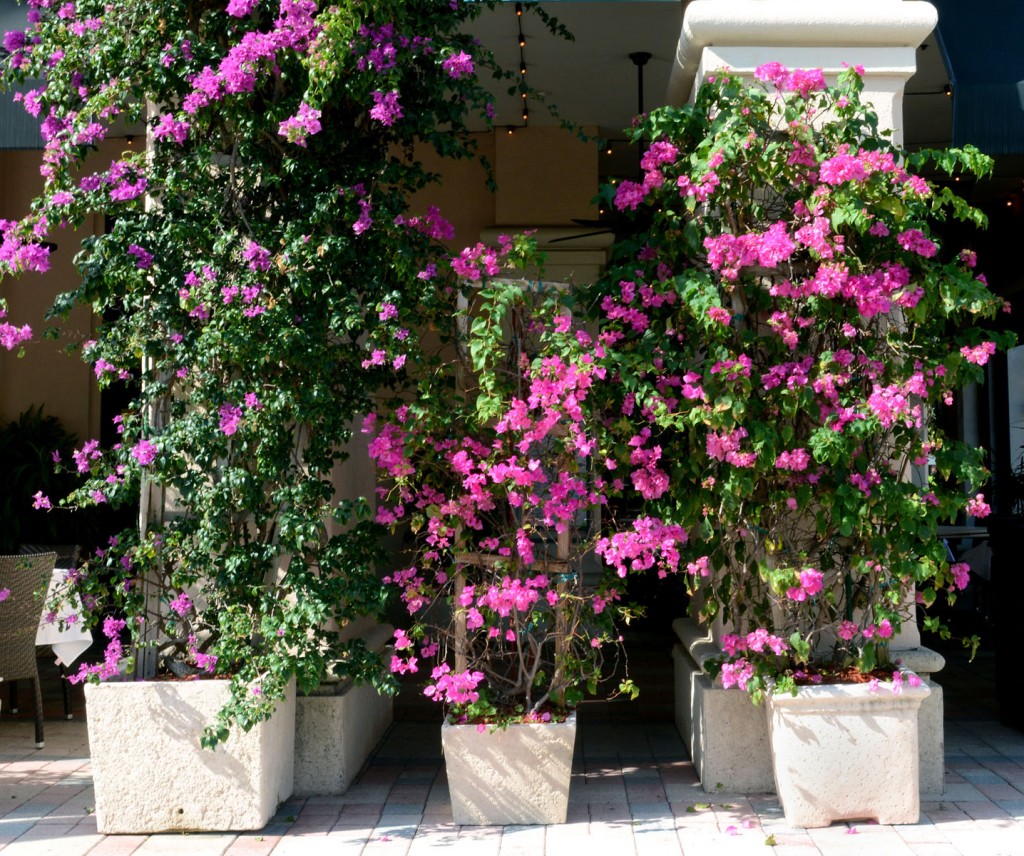
Commercial concrete planters can also serve as barriers to direct traffic.
Have you heard of “curb appeal?” If you watch home renovation TV shows, then you know curb appeal is a very real asset to selling a property. Similarly, it can make a huge difference in helping guests feel invited so they want to return to your facility. You see, curb appeal is all about first impressions, and it’s well known that first impressions make a massive difference. When you arrive at a restaurant, if the floors are dirty, the trash is overflowing, and the wait staff greets you by sighing and rolling their eyes, chances are you will turn around and walk out the door before spending a dollar. But if there is gentle music playing in the background, clean and inviting tables, subtle décor, and the staff offers you a sample, you will probably stay, enjoy a meal, and return again later. When guests first arrive at your facility, they immediately make assumptions based on what they see, whether they know it or not. Part of that is evolutionary—as cavemen, we had to quickly comprehend the environment around us to avoid hazards. Researchers found that first impressions register in the brain as quickly as 1/10th of a second. For that reason, it’s essential that guests feel like they are at a facility that is well kept. A few quality planters with colorful, classy plants can make a tremendous difference. You can also select planters that are made from recycled materials, as identified with the recycle symbol. This will communicate your facility’s priority to the environment before guests even shake your hand. If the outside of your facility is outdated, commercial planters can give it a facelift while cheaper than painting or resurfacing the entire property. You don’t need to remove the current bushes or landscaping at your facility, just add a few wood, concrete or fiberglass planters. You will be shocked at what a huge difference the small splash of color makes for your facility, without straining your budget.
Commercial vs. Retail Planters: Know the Difference!
When selecting a planter, there is a big difference between commercial and retail planters. Selecting the wrong one for your facility could mean having to replace it later on, costing you more in the long run. Commercial planters are specifically designed for businesses and public use facilities. They are generally larger, heavy-duty, and may come in muted tones like brown, tan, or white to match any location. Due to their size and heavy design, such as large concrete planters, commercial
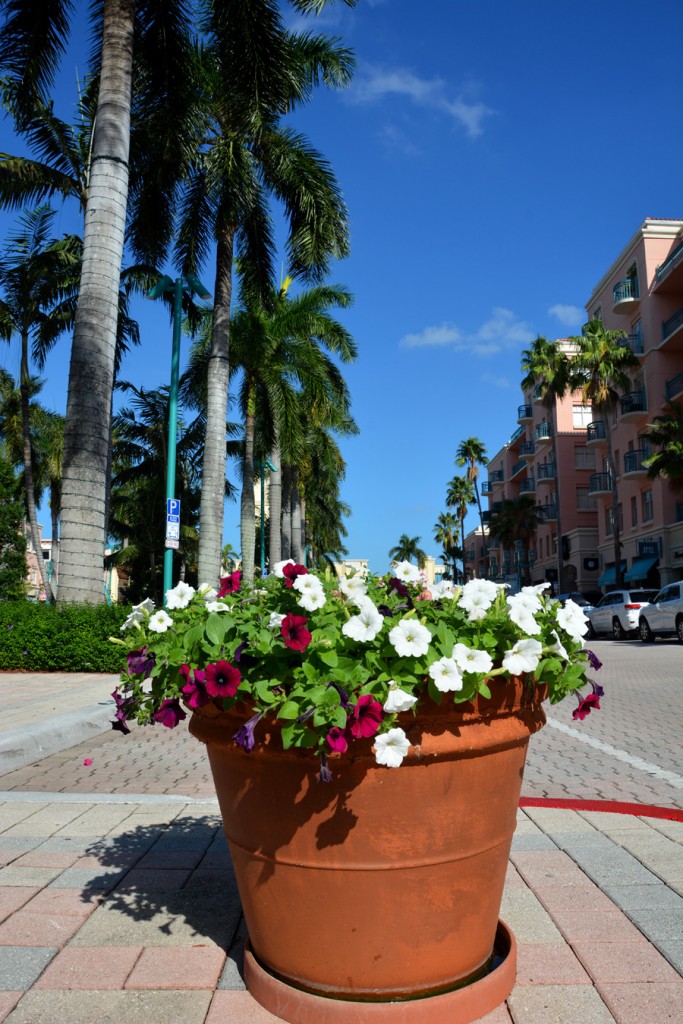
A planter adds a nice dash of color to any landscape.
Retail planters are found in your local hardware stores. They are smaller and designed for use around the house. While some offices, parks, or stores may use retail planters at their facility, these really aren’t designed for that purpose. Guests can easily bump into planters, and small retail planters will quickly chip, crack, tip over, or break. For this reason, retail planters can even be a liability as they can potentially injure visitors—especially those with small children who don’t know any better. If you need planters for your location, go with sturdy commercial planters. They are safer, a stronger investment, and designed for use in public. Don’t leave your planter empty! Flower and plant tips Once you select the perfect planter for your facility, it’s time to get planting! Some plants are more low-maintenance than others, and you will want to carefully select a variety of plants to make your facility look colorful, bright, and professional. A few popular plant selections include:
- Spider plant: This is popular indoors because of its low maintenance and wispy, casual appearance.
- Sedum: This low-maintenance perennial will attract butterflies and emerges quickly each spring.
- Peace Lily: These are common indoor plants that require little water and grow easily in the shade.
- Lantana: Blooming, colorful flowers that typically only grow in warmer climates. In colder climates, simply grow it in a container and move it indoors during the winter.
- Quartz Rose Verbena: These grow profusely all season when planted in full sun.
- Hanging plants: If you are limited on indoor space, consider hanging some plants in a corner of the room to make the appearance of more depth and space.
- Blue Lyme Grass: Cool season grasses like the Blue Lyme Grass are dormant in the winter, but return each spring to add some low-maintenance color and height to your plants.
- Jules Verne Peony: Adding colorful, fragrant flowers to your facility, this low-maintenance peony only needs light fertilization in the spring to add abundant color to your facility.
- Endless Summer Hydrangea: This shrub’s flowers change from lime green to bright pink. Do not plant these if your facility has deer—they will get eaten!
When filling your planters, try to abide by the following rules:
- Balance out your plants. In one planter, you will want to plant flowers from opposite ends of the color wheel. Oranges and blues go together well, as do greens and reds or pinks. Texture is also a consideration—include both plants that are soft and rough, or grassy and velvety. Also be sure you balance the height and shape in your planter by including shorter and taller plants.
- Include thrillers, fillers, spillers. Along those same lines, make sure your commercial planter has thrillers, fillers, and spillers for the ultimate look. Thrillers are tall plants like poppies that add height. Fillers are daisies or similar flowers that add horizontal depth and make the plant look full. Spillers fall over the edge of the plant to give it the appearance that it’s overflowing with floral beauty–ferns make great spillers.
- Don’t neglect growing conditions. It’s easy to get creative when combining thrillers, fillers, and spillers of all varieties, but keep the basics of successful planting in mind is essential. Only combine plants that have complimentary growing conditions and sun requirements—some require full sun while others need shade.
- Use Proper Drainage Techniques - make sure your planter is a firm base such as concrete or gravel and keep it level so all the water can dispese through the drain holes.
- Add Gravel - a smart move for planters is to add about eight inches of gravel, about one-inch in size, to the bottom of the planter and then covered with a permeable layor of netting or fabric. This permits the water to drain from the bottom, decreases the chances of overwatering. This also keeps water out of the planter in the winter, when freeze/thaw cycles can cause cracking. Fill the rest of the planter with soil, perlite or much, depending on the plant involved.
Keep in mind that the type of planter you select will also add color, shape, and style to your facility. Short and oval or tall and square shapes, along with black, white, tan, patterned, or minimalist designs, can all make a big impact on the vibe at your facility. Plan ahead to ensure that your planters match existing and future designs.
Finding the best type of planter
Depending on what your facility needs, you will want to carefully select from the different types of planters to choose the best option for you.
Concrete Planters
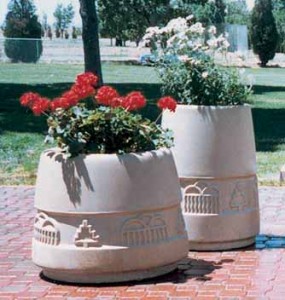
Concrete planters use the heaviest material available. This makes them more durable, protective of plants, and very difficult to steal. However, if you want to move your plants frequently, concrete may not be the best option because of how difficult they are to relocate. They usually require a forklift to move. Be sure to double check the shipping arrangements for large commercial outdoor planters as there may be special requirements. Concrete is also more expensive due to its durability. But you can be sure of one thing, these planters will stay where they are placed.
Fiberglass Planters 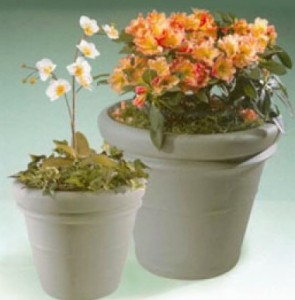
Fiberglass planters are lightweight and easy to move, making them versatile for your facility. These commercial planters are a popular choice in landscape design and usually comes in a variety of colors and designs, with matte, glossy, or faux stone finishes. While lightweight, fiberglass is still very durable and difficult to break, great at retaining moisture, and resistant to mold.
Wood Planters
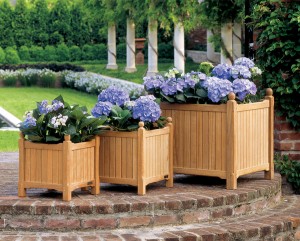
Wood planters provide a classic rustic look, but can be affected by weather damage and require sanding and re-finishing to maintain. As an alternative to wood, hardwood is created from shorea plants to ensure that it does not rot or require any finishing. These commercial planters are easy to relocate around a property, which can be an advantage for landscapers.
Metal Planters
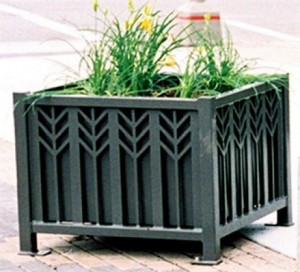
Metal planters offer a lightweight option that has a modern look and comes in a variety of colors and styles. Make sure the metal planters you purchase are finished with anti-corrosive iron phosphate and powder coating to prevent rusting and fading. These are maintenance-free.
Polymer Resin Planters
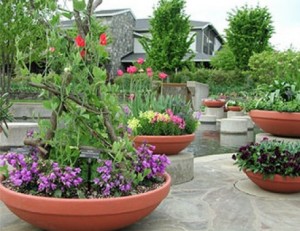
Polymer resin planters are strong and sturdy like stone and metal, while still very lightweight. They are resistant to chips, cracks, rust, and scratches, and can be up to 75% lighter than other types of planters. This planter does not require maintenance.
Planters can direct traffic. Yes, really!
A little-known benefit of planters is their ability to direct foot traffic. Guests naturally walk around planters, which is something you can use to your advantage. Installing planters can direct guests in these ways:
- If you have large hallways and want traffic to flow either direction (like a two-lane road), commercial planters can divide the walkway into two areas. Most guests will naturally walk on one side of the walkway, reducing the discomfort that comes when walking head-on towards another guest.
- Block restricted areas with tall, full plants in large commercial planters. It’s much lovelier than a “Do Not Enter” sign, but it still gets the job done by keeping people out.
- Direct pedestrians or cars using planters. In downtown areas, it is difficult to keep vehicles out of medians or pedestrian areas. It can also be hard to block pedestrians from walking in dangerous places. Planters, especially large concrete planters filled with tall trees, are excellent at directing both cars and people, keeping everyone safe.
- By strategically placing your planters, you can also emphasize different areas of your facility. Make your entrance look grand by drawing visitor’s eyes to the front door. At a retail location, planters can bring guest’s attention to an advertisement or window display, encouraging them to enter and leading to increased sales.
Installation in 5 Easy Steps
Commercial planters are simple to install, as they typically do not require hardware.
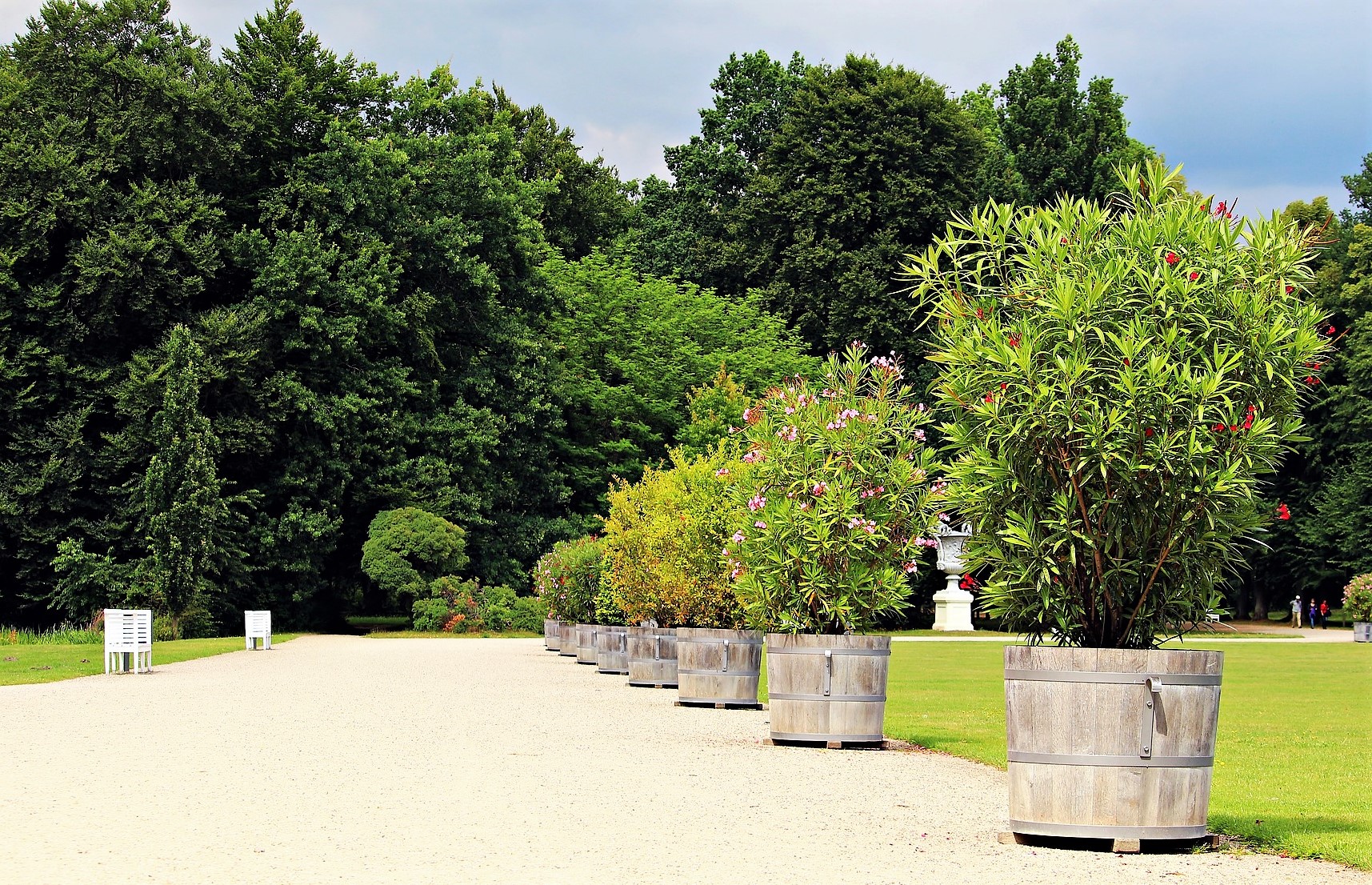
Large commercial planters are one way to quickly add small trees to a landscape.
- Unbox your new planter and place it where it can grow easily, while also making your facility look nice.
- Add soil, fertilizer, seeds, bulbs, flowers, plants, etc. to your planter.
- Water the plant. Many planters have a drainage hole on the bottom to prevent overwatering, but you can also purchase one without the hole, if that’s preferred.
- If it is a metal or lightweight planter with screws for securing the legs, screw in the hardware to the ground.
- Water the planter every day or every few days, depending on the type of plants you select.
Final Tips and Tricks for Your Planters
Now, you are ready to purchase and install a commercial planter and make your facility look brighter and more inviting than ever before. Remember these final tips for your commercial planters:
- Match what you already have by selecting planters with colors or styles specific to your facility. Plan on having all of your planters match one another in a specific theme.
- Thrillers, fillers, and spillers will make your planters look full, beautiful, and inviting as they give depth to your plants and make them look like they are overflowing with life.
- Place your planters carefully and they can direct traffic, keep guests safe, and block off restricted areas.
- Freshen up your outdoor planters every few months to keep your area from looking tired. As planters chip and age, replace or repair them.
- Bring planters indoors during the winter time or evenings. This can prevent your flowers from freezing or getting stolen or damaged. Wheels or casters make this task much easier.
References
About Flowers. “Harvard: Flowers Boost Morning Moods.” http://www.aboutflowers.com/home-decorating-with-flowers-a-plants/kitchen-flower-recipes/354-harvard-research-shows-flowers-are-the-perfect-pick-me-up-to-boost-morning-moods.html Ambius. “Office Plants Gallery.” http://www.ambius.com/indoor-plants/gallery/offices/index.html Birds & Blooms. “Top 10 Low Maintenance Perennials.” http://www.birdsandblooms.com/gardening/drought-tolerant-gardening/top-10-low-maintenance-perennials/ Inhabitat. “9 Low-Maintenance Plants for the Office.” June 29, 2015. http://inhabitat.com/9-low-maintenance-plants-for-the-office/ NorthPark Shopping Center. “Landscaping and Architecture.” http://www.northparkcenter.com/pages/northpark-landscaping Plant Professionals. “10 Modern Ideas for Interior Plant Design.” September 29, 2016. http://www.plantprofessionals.com/10-modern-ideas-for-interior-plant-design/ The Park Catalog. “Five Reasons Why You Should Add Commercial Planters This Spring.” March 29, 2016. https://www.theparkcatalog.com/blog/commercial-concrete-planters-this-spring/ The Park Catalog. “Commercial Planters Can Quickly Add Curb Appeal for Renters.” December 2, 2014. https://www.theparkcatalog.com/blog/commercial-planters-curb-appeal/
About The Park and Facilities Catalog
The Park and Facilities Catalog is headquartered in Boca Raton, FL. In business since 2001, the company is a national provider of commercial-grade commercial planters made of concrete, wood, fiberglass, metal, polymer resin, glass fiber-reinforced concrete, and other durable materials. The company also supplies other outdoor site furnishings such as bicycle parking racks, picnic tables, aluminum bleachers, lockers, receptacles and other Division 10 and 12 construction items. Our thousands of clients include municipalities, parks, businesses, contractors, architects, schools, universities, multi-family communities, shopping centers and office buildings from around the country. Contact one of our expert team members to find the appropriate park grills for your needs and location. For more information call 1-800-695-3503 or visit the website at https://www.theparkcatalog.com/planters.



